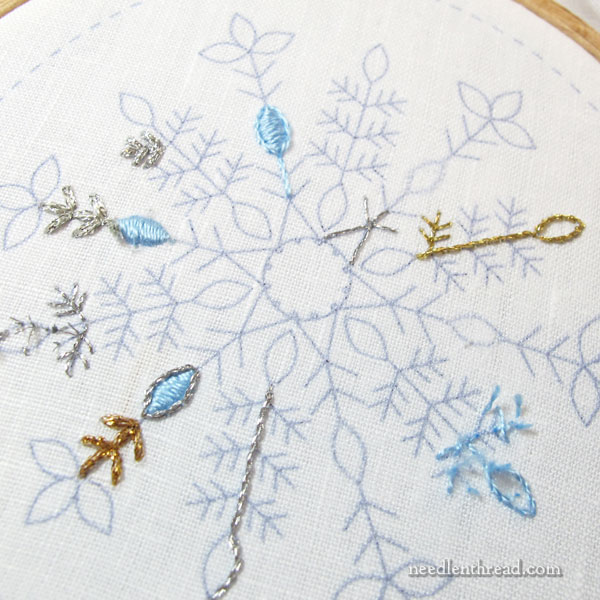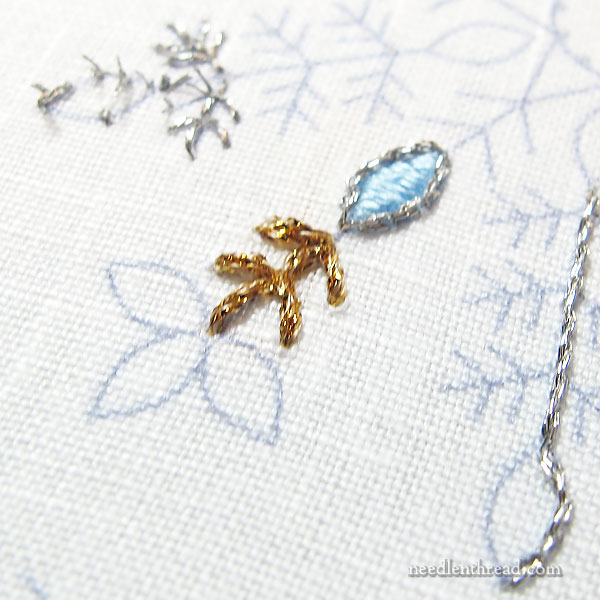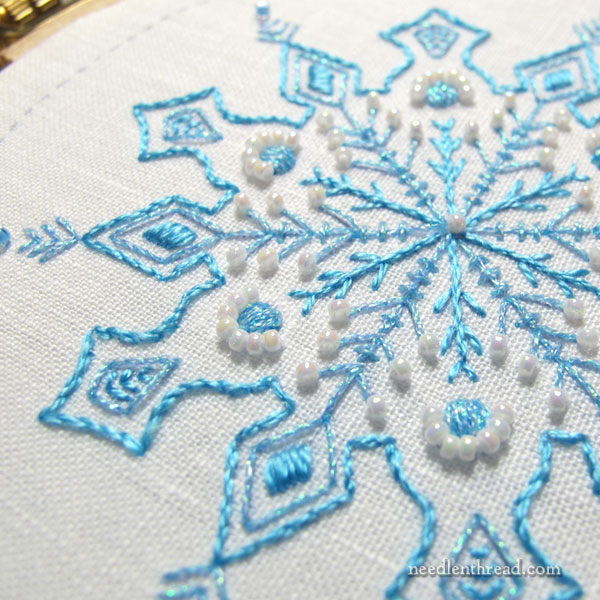Design ideas and embroidery ideas don’t always work.
It’s true! They don’t! Sometimes, in fact, they’re utter failures.
It takes testing, time, and sometimes a good dose of frustration to arrive at a design, a technique, a thread, a stitch, or an embellishment that leads to a resounding, “Oh yes! That will work! Yay!”
Some people might think it takes a lot of waste, too.
It’s true that there are pieces of embroidery that I entirely scrap, because they won’t work out. It’s true that I might go through a spool or a skein of thread before I admit that, as much as I like the thread, it won’t work for this. It’s true that I might spend a whole afternoon – maybe even a whole day – maybe even three days! – on a particular design or working with a particular thread, before I say, “No. This Just Won’t Work.”
None of that is waste. It’s called process – more specifically, it’s called the learning process. And all of us go through it to some degree or another every time we sit down to stitch. Embroidery designers go through it pretty often – mostly so that you don’t have to!
I’ve been working through a collection of snowflakes, and some have worked out fine. Others have been a wash. Here’s a bit of process for you, in case you ever wonder what goes on when I’m exploring and testing embroidery designs and ideas.

This flake started out with experiments in satin stitch with some different colors of blue thread that I planned to combine with silver.
All the satin stitch evidence is no longer really there, though you can see some remnants. I must have satin stitched 12 or so of the marquis shaped design elements in this thing, stitching them, picking them out, trying again with a different color, with a different stitch direction, with padding, without padding, outlined, not outlined … before I said, “Nope. It just isn’t working for me.”
It’s not that I don’t like satin stitch. It’s not that I don’t like the thread. It’s not that I can’t do satin stitch (though the examples above might make you wonder!)… it’s just that no combination of any of the above made the thing sing for me. There was no A-HA! moment.
And while sometimes, you have to plug away past your consternation to see how The Whole will work, as opposed to just The Part – in this case, I knew I didn’t like it.

The poor piece of linen went through some serious havoc with all the stitching and unstitching.
But that’s the great thing about good linen – it takes a lickin’ and keeps on tickin’! (Thank you, Timex.)
Instead of scraping this piece, I put it to use to test a few threads and other stitching ideas, using sections of the snowflake to decide if this thread or that approach would work.
So what you’re seeing above is not some kind of wild patchwork snowflake. It’s a test subject.
And while it won’t give me an idea of what the whole flake will look like in any particular technique or thread, it will give me an idea of what ideas to forget about entirely (on any flake) or what approaches might work well.
I dabbled for several hours this way. And it was not wasted time!

Two of my discoveries: at some point, satin stitch outlined in a very fine stem-stitched silver might work. Gargantuan gold braid … will not work. It’s far too heavy for the fabric and the design.
Keep in mind, the designs are about 3″ from their farthest points in diameter, so these are small. #16 braid is bulky and huge on something like this, so I can set that thread aside and forget about it entirely.
I know some of you are relieved! The die-hard “All Snowflakes Must Be Silver or White” people probably find the gold appalling. But I’m thinking of folks who like to decorate with gold and white or gold and red and similar color schemes. They might appreciate seeing how the designs work out in something other than blues, silvers, whites and other icy tones.

Again, this delicate silver metallic stitches up well in stem stitch – it’s a possibility!

And its gold cousin also works. It is a nice, delicate thread for the spindly arms, too, and it works up quickly in fern stitch (or just a series of straight stitches).

Some designs don’t work at all.
I doodled up a snowflake that had little angels as the primary spokes. They were kind of hidden and subtle, since from afar it looks like a snowflake. Get close, and you see the angels. But to fit that kind of detail into a 3″ round, even stitching it with one single strand, just doesn’t do it.
It might work for a larger something, but I don’t like the fiddliness of the design at this size, and since it’s not “singing” to me – despite what it may look like – I put this one aside for now.
So, yes, sometimes whole designs go away during this stage of exploration!

Sometimes, though, design elements that I was a little hesitant about (i.e., the half circles of tiny 15/0 white iridescent beads on this snowflake above) come together just as I hoped they would when the whole design is finished.
The camera doesn’t quite catch the iridescence in the beads that makes them work really well with the iridescent metallic thread. When I was finished with this flake – which I knew I had to finish to get the whole picture, despite some misgivings on the beads – I liked it a lot. It worked, and the situation of the beads did what I wanted it to do, making a kind of wall or stopping point around the inner part of the snowflake.

This Floofy Flake design – the super-stylized snowflake that I showed you when we first started talking about these things – is a springboard for demonstrating color combinations. I showed you it in blue, with blue pearls, in this article.
This gold version is stitched in silk, with creamy seed beads. The beads look a bit larger than life in the photo – they don’t come across that large in real life!

After playing with beads and metallics and silks and cottons, you start thinking that there’s no such thing as a snowflake without sparkle. This one got 24k gold-plated delicas. The jury’s still out…
So that’s a bit of process for you! I know it looks like a lot of fun – and it is a lot of fun! – but there’s also the pressure of time constraints, the pressure of actually finishing something, the frustration of ideas that just don’t pan out.
Still… all that negative hooey aside, yes! It’s a heck of a lot of fun! So no complaining on this end. I can’t wait to get back to it!
Today, I’ll be converting three drawings into suitable designs for stitching and then turning them into vectors on the computer. So between bouts of stitching, there’s a bunch of computer work that goes into this type of thing, too. I figure I’ll be in front of the screen for about six hours or so before I can return to the stitching table.
Hey, it’s all part of the process! And I love it all!
Enjoy your weekend!







Hi Mary,
I really enjoy reading you and love the way you express your feelings sharing them so truly… thank you 🙂
I’ve been following the progress of your snowflakes since the beginning as your gorgeous works always catch my attention with their meticulous detail and colors associations in such little 3″ space.
For me too, the process of creating is a constant va-et-vient, sometimes frustrating, sometimes motivating, but it sure isn’t a waste of time at all, and all the details you are paying to attention matter so much, who else if not first the artist-creator himself could make another person feel his work? 😉 I’m working as a passionate architect in my own office and I’m also a passionate yarn-craft-addict… photographies, DIY, e-mails, orders… computer work to support all of this is enormous and we have the chance it helps us a lot 😀
Wish you all the best and thank you again for sharing.
Happy weekend to you too !
Have you thought about couching silver metallic threads close together where you were did the satin stitch. Also sew on oblong crystals. What do you plan to do with your snowflake? You thought of using a darker linen, perhaps midnight blue or black? I like watching a design in progress. Thank you for inviting your followers.
Mary this was such a timely post for me. I recently abandoned a cross-stitch I was doing. I had a lovely hand-dyed piece of aida and had spent hours and hours converting the colour scheme to better fit this aida. In converting the thread colours, I had first stitched the piece as-is on a plain piece of aida so I could see the density of the original thread colours next to each other. I made a few changes and happily started my new piece and it just doesn’t work! I could unpick some of the colours and re-do it, but the whole thing doesn’t work. The hand-dyed aida is a smaller count and some of the blended colours are too big really. It has indeed been an exercise in education.
Thank you Mary for sharing . . . while I love the absolute perfectly pretty final projects, I find the process oh so interesting!
I appreciate this glimpse into the design process. I am often asked how I have the patience to stitch but the patience needed for this part is much more demanding I think! Thank you!!
So glad I came across this! I always get so frustrated, I plan my designs on photoshop with several color swatches, I carefully study where everything should go to be beautifully placed, print, sleep on it and finally transfer to fabric. Than what happens? It’s impossible to stitch! 🙁
But that’s the beauty of art, specially when you are working with so many fabrics, threads and colors! It’s fun when you get to experiment and learn what works and what doesn’t! Happy to know I am not alone! Thanks for sharing your experience 🙂
Hi Mary – sorry I did not get to comment on this post immediately but I really appreciate this one! It’s very informative on so many levels. Thanks for showing us the behind-the-scenes process. There’s just never enough designing-level posts going around that actually explains in detail the designers aim and intention. This one is super helpful! (I was itching to add a final hyphen to that last word but kept myself in-check!)
Thank you for a great little article. It really is helpful to me as a beginner. I love all the snowflakes.
You got me started to use a doodle cloth when attempting new more difficult stitches, like bullion knots. It’s great to look back and see how my knots improved with a bit of practice when I’m feeling a bit inadequate needlework-wise some days, or am tempted to shortcut and don’t want to put in the effort of trying out before plunging in on the actual project.
Do you ever keep your experiments like this snowflake as a doodle cloth record of what you tried, or do you always photograph and then rip out? It seems like I’ll see things in real life that the camera doesn’t pick up. Then again, the camera will see things differently than my eyes & brain do.
Which brings up a “behind the needle” question – you wrote earlier that you photograph the threads with the tags next to what you’re stitching – awesome idea. What about tracking which fabric you are using, especially when using various slightly different whites or thread counts?
I love this post, thanks so much for sharing some of your designing process Mary! This is something I struggle with too, both when creating a project and with making variations to a pattern. It’s hard to make it “sing”! And there is so much time and energy involved in trying things that you think will work, so it can be very frustrating and disappointing when you can’t get the stitching vision you have in your head to manifest through your hands 🙂 I love the red snowflake with the gold beads, it’s traditional but modern and would beautiful on a Christmas tree!